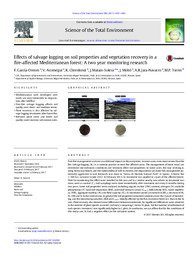Por favor, use este identificador para citar o enlazar este ítem:
https://hdl.handle.net/11000/5256Registro completo de metadatos
| Campo DC | Valor | Lengua/Idioma |
|---|---|---|
| dc.contributor.author | García Orenes, Fuensanta | - |
| dc.contributor.author | Arcenegui Baldó, Victoria | - |
| dc.contributor.author | Chrenková, K. | - |
| dc.contributor.author | Mataix Solera, Jorge | - |
| dc.contributor.author | Moltó, J. | - |
| dc.contributor.author | Jara Navarro, Ana Belén | - |
| dc.contributor.author | Torres, M.P. | - |
| dc.contributor.other | Departamentos de la UMH::Agroquímica y Medio Ambiente | es |
| dc.date.accessioned | 2019-09-04T06:49:58Z | - |
| dc.date.available | 2019-09-04T06:49:58Z | - |
| dc.date.created | 2017-02-15 | - |
| dc.date.issued | 2019-09-04 | - |
| dc.identifier.issn | 0048-9697 | - |
| dc.identifier.issn | 1879-1026 | - |
| dc.identifier.uri | http://hdl.handle.net/11000/5256 | - |
| dc.description.abstract | Post-firemanagement can have an additional impact on the ecosystem; in somecases, evenmore severe than the fire. Salvage logging (SL) is a common practice in most fire-affected areas. The management of burnt wood can determine microclimatic conditions and seriously affect soil properties. In some cases, the way of doing it, using heavy machinery, and the vulnerability of soils to erosion and degradation can make this management potentially aggressive to soil. Research was done in “Sierra de Mariola Natural Park” (E Spain). A forest fire (N500 ha) occurred in July 2012. In February 2013, SL treatment was applied in a part of the affected forest. Plots for monitoring this effect were installed in this area and in a similar nearby area where no treatment was done, used as control (C). Soil samplings were done immediately after treatment and every 6 months during two years. Some soil properties were analysed, including organic matter (OM) content, nitrogen (N) available phosphorous (P) basal soil respiration (BSR), microbial biomass carbon (Cmic), bulk density (BD),water repellency (WR), aggregate stability (AS) and field capacity (FC). SL treatment caused an increase in BD, a decrease of AS, FC, OMand N. In the control area, in general the soil properties remained constant across the 2 years of monitoring, and the microbial parameters (BSR and Cmic), initially affected by the fire, recovered faster in C than in the SL area. Plant recovery also showed some differences between treatments. No significant differenceswere observed in the number of plant species recorded (richness) comparing C versus SL plots, but the number of individuals of each species (evenness)was significantly higher in C plots. In conclusion, we can affirmthat for the conditions of this study case, SL had a negative effect on the soil-plant system. | es |
| dc.description.sponsorship | To the “Ministerio de Economía and Competitividad” of the Spanish Government for financing the POSTFIRE project (CGL2013- 47862-C2-1-R) and Alcoi council | - |
| dc.format | application/pdf | es |
| dc.format.extent | 9 | es |
| dc.language.iso | eng | es |
| dc.rights | info:eu-repo/semantics/openAccess | es |
| dc.subject | Wildfire | es |
| dc.subject | Burnt soil | es |
| dc.subject | Salvage logging | es |
| dc.subject | Post-fire treatments | es |
| dc.subject.other | 631 - Agricultura. Agronomía. Maquinaria agrícola. Suelos. Edafología agrícola | es |
| dc.title | Effects of salvage logging on soil properties and vegetation recovery in a fire-affected Mediterranean forest: A two year monitoring research | es |
| dc.type | info:eu-repo/semantics/article | es |
| dc.identifier.doi | 10.1016/j.scitotenv.2017.02.090 | - |
| dc.relation.publisherversion | http://dx.doi.org/10.1016/j.scitotenv.2017.02.090 | - |

Ver/Abrir:
9-García-Orenes et al. STOTEN 2017.pdf
1,22 MB
Adobe PDF
Compartir:
 La licencia se describe como: Atribución-NonComercial-NoDerivada 4.0 Internacional.
La licencia se describe como: Atribución-NonComercial-NoDerivada 4.0 Internacional.
.png)